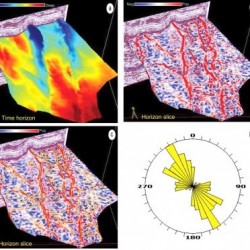Explore our expert
Optimizing Production with Fracture Analysis
Using fracture data analysis to optimize well plan, well geometry and production.

Fracture is one important structure to consider for fluid production from reservoir oil, gas production and hydrothermal. Fractures were mainly associated with fault due to tectonic activity or rock relaxation. Fracture analysis was also related with fault identification. In terms of reservoir, fracture be:
1. Additional porosity in reservoir rock. Rock porosity can be caused by void in rock bulk. I can be inter granular porosity, vug, remaining organic burrow and fracture. Additional porosity in fractured reservoir is around 3-5%. This additional porosity is very important in case of tight reservoir (unconventional reservoir).
2. Fracture increase permeability by long opening void geometry and connecting intergranular porosity. In many case it support the fluid production but some case it also conducts water column to the well. Understanding geometry of fracture and fault is very important in this case to avoid the mistake during well test and not damage the well due to water flush during testing.
3. In many case around the world fractures are the main porosity and permeability in crystalline rock. Some oil field produce hydrocarbon as secondary target but some place in North Atlantic, Sumatra and South Borneo, fractured basement become main target production. Understand the pattern of fault will optimize well geometry, increase productivity and increase the economic value of the field. This also applies for hydrothermal reservoir.
Fractures were analyzed by identification of associated fault, distance fractured area around the fault and surface analogue to get the property of fracture. In the real case not all fault associated with fractures. Normally fault growth finish when fault is happening. It is because the energy was released as fault movement. Understanding fault type and associated fracture required more advance technology.
The latest technology to identify fault from 3D seismic data is edge detection. We use this technology to identify fault and amplified fault which associated with open fractures. The fractured area then transfer to cells in static geological model. Fracture cell can be transfer to fault and fracture property such as porosity and permeability from well and surface data. This method is more accurate because extract real information from 3D seismic and it can distinguish non fracture associated fault with fracture associated fault.
We use this method to analyze data to optimize well plan, well geometry and production on various blocks in Indonesia.
Please contact our marketing at marketing@ptgtn.com for detail inquiries, proposal, brochure and pricing.